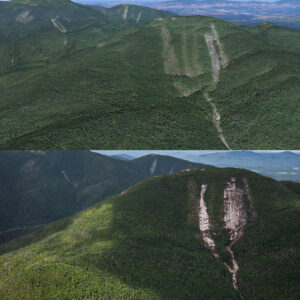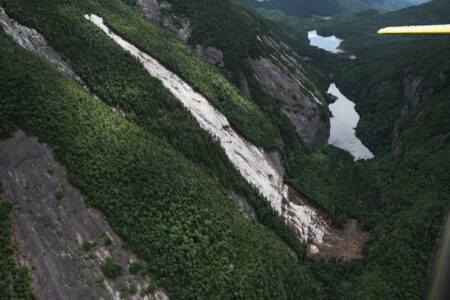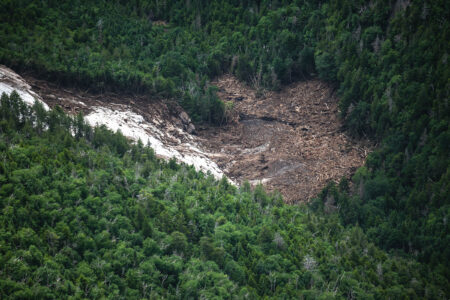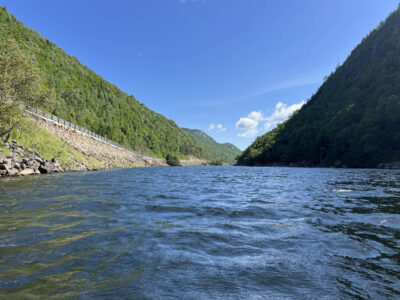Avalanche Pass trail remains closed
DEC monitors mudslide debris aftermath; Reopening timeline yet to be announced
- A set of photos depicting the before (above) and after (below) appearances of Mount Colden’s southeastern face after several new slides were created by mudslides that occurred overnight between July 13 and 14. These slides caused some trail damage to the Lake Arnold trail, but it was not as extensive as the Avalanche Pass damage, and the Lake Arnold trail remains open with a short detour around the damage. (Provided photo — Jonathan Zaharek)
- One of the new slides, the third rock slab from left bearing a lighter coloration than the other slides, and its debris pile on the northwest face of Mount Colden is seen from the air on July 22. The debris field closed the trail through Avalanche Pass. (Provided photo — Jonathan Zaharek)
- The Avalanche Pass debris field from a new slide that formed on Mount Colden’s northwestern face overnight between July 13 and 14 is seen on July 22. The mud, which is up to 20 feet deep in spots, resulted in the closure of the trail that goes through the pass. (Provided photo — Jonathan Zaharek)

A set of photos depicting the before (above) and after (below) appearances of Mount Colden’s southeastern face after several new slides were created by mudslides that occurred overnight between July 13 and 14. These slides caused some trail damage to the Lake Arnold trail, but it was not as extensive as the Avalanche Pass damage, and the Lake Arnold trail remains open with a short detour around the damage. (Provided photo — Jonathan Zaharek)
AVALANCHE PASS — Hikers hoping to make their way through Avalanche Pass in the High Peaks Wilderness will have to wait. How much longer, exactly? That’s still unknown, although it likely will not reopen anytime soon.
A portion of the Avalanche Pass Trail has been closed by the state Department of Environmental Conservation since July 14 following a mudslide on Mount Colden’s northwestern face. The mudslide either occurred during the early morning hours that day or during the late night hours of July 13. The trail is closed from its intersection with the Lake Arnold Trail to the southern end of Avalanche Lake.
Nobody was injured or killed as a result of the mudslides, several of which occurred that night. While the Avalanche Pass one caused the most trail damage — given the slide’s close proximity to the route and the pass’s narrow width that the trail runs through, limiting where the debris could spread and instead concentrating it over the trail — there were other impacted areas as a result of separate mudslides.
These include the Lake Colden Trail on Mount Colden’s northwest side and the Lake Arnold Trail on the mountain’s southeastern side, specifically between Lake Arnold and the Feldspar Lean-to and camping site. These sections of trail are open, though short “bushwack” detours around the debris are required.
The trail damage in the closed portion of Avalanche Pass is extensive. A DEC spokesperson said the debris field covers the entire width of the pass.
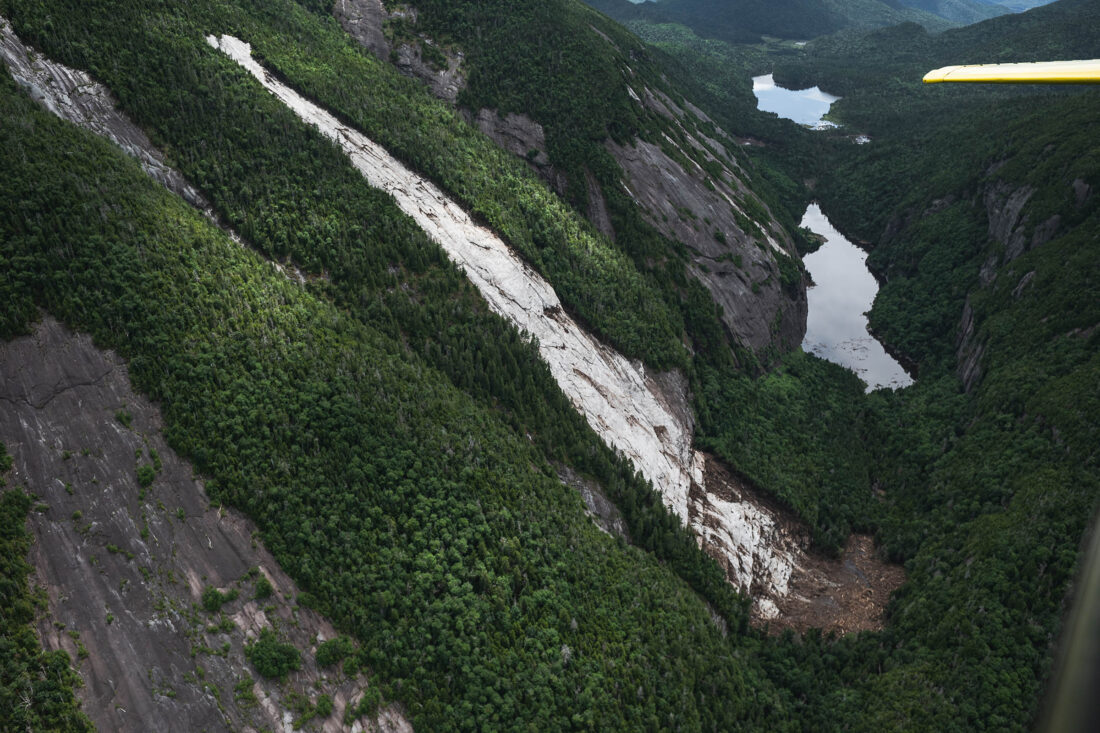
One of the new slides, the third rock slab from left bearing a lighter coloration than the other slides, and its debris pile on the northwest face of Mount Colden is seen from the air on July 22. The debris field closed the trail through Avalanche Pass. (Provided photo — Jonathan Zaharek)
“The slide that hit Avalanche Pass has a debris field that is the full width of the pass, has deep wet areas and a jumble of trees and roots,” the DEC spokesperson wrote. “The debris pile is well over 20 (feet) in the middle of the pass (width) with the far wall of the pass probably exceeding 40 (feet) where it hit the opposite wall. The mud ranges to well over 4 (feet).”
The DEC added that the Avalanche Pass Trail remains closed while the agency monitors the dewatering of the debris field, to make safe and informed decisions on the best way to reestablish a trail in this area.
The DEC did not provide a timeline as to when the trail might reopen or what the next steps to that will be.
Mark Simpson is a Trail Master — one of the lead trail builders for the Adirondack 46ers. Simpson has volunteered with the organization for the past 19 years. After finishing climbing all 46 High Peaks, Simpson wanted to “pay it forward” and give back to maintaining and improving the trails that have given him so much enjoyment as a hiker.
The Adirondack 46ers is a nonprofit organization that, along with several partner groups, works with and sometimes on behalf of the DEC to maintain trails in and around the High Peaks Wilderness zones, among other stewardship endeavors the Adirondack 46ers engage in as part of its mission to “protect and foster the natural resources within the Forest Preserve located in the Adirondack Park of the State of New York and to preserve the wilderness character of the region,” as stated in its bylaws.
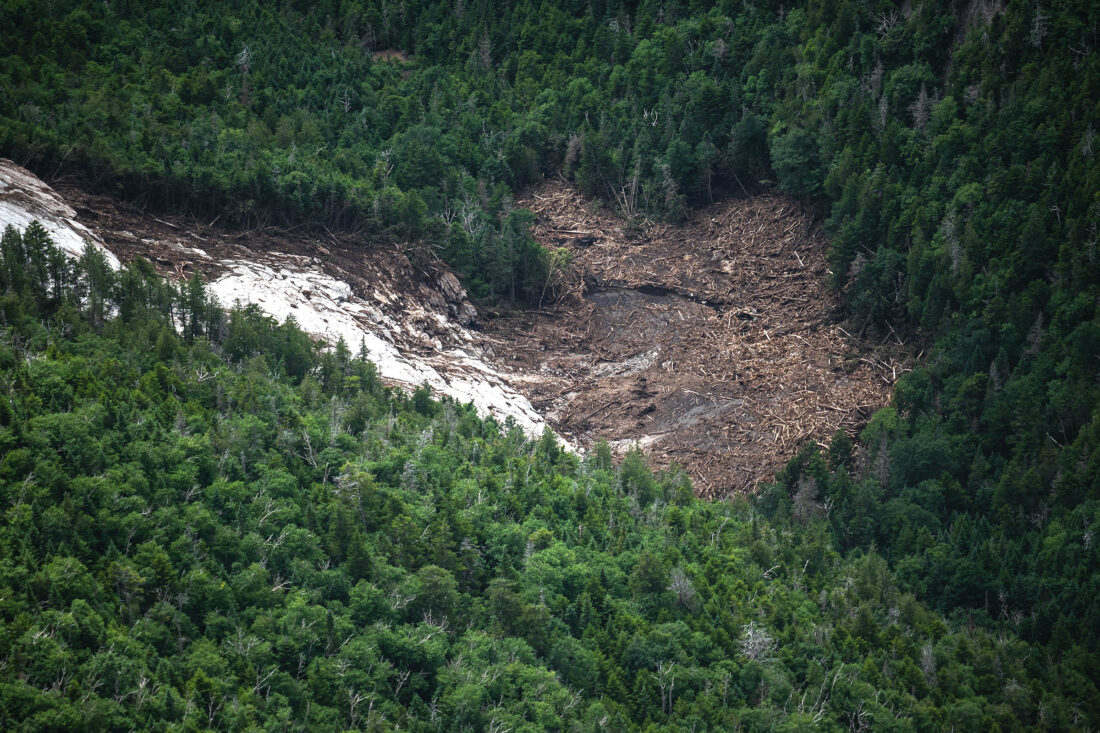
The Avalanche Pass debris field from a new slide that formed on Mount Colden’s northwestern face overnight between July 13 and 14 is seen on July 22. The mud, which is up to 20 feet deep in spots, resulted in the closure of the trail that goes through the pass. (Provided photo — Jonathan Zaharek)
Simpson noted that when it comes to trail building and rebuilding, those decisions are ultimately made by the DEC. He wasn’t speaking from a position of authority on the next steps for repairing this trail and wasn’t aware of what the DEC would ultimately decide to do there. Leaning on his nearly two decades of trailwork experience in the High Peaks wilderness, though, Simpson offered some insights into what a possible trail rebuild may look like.
“The water will have to leach out and then, very likely, a series of bog bridges,” he said. “Very low-lying bridges, just basically planks on planks put over the top in some way so you can get over the mud.”
Given the volume of mud in Avalanche Pass and the frequent rains the Adirondacks receive, the dewatering process could take some time. Simpson said he wouldn’t be surprised if the Avalanche Pass section of trail remains closed for the rest of the year, or longer.
“It’s an amazing pile of mud,” he said. “And it’s going to take quite a while for the water to leech out. Just how long? Who knows.”
He said mudslides are nothing new for Mount Colden, and while they’re not exactly a regular phenomenon, the mountain’s slope angles — as evidenced by the mountain’s numerous open rock slab routes that existed before this month’s slides — are ideal for slides in that they’re steep enough for slides to occur during extreme rainfall events, but are shallow enough for the vegetation to regrow over time, which provides the eventual debris for the next mudslide.
“It’s been doing this for a long time,” Simpson said. “These slides will get overgrown and then … it’ll happen again.”
–
Alternative routes
–
Avalanche Pass is a major connecting trail in the High Peaks, providing the most direct route between the Adirondak Loj trailhead to the north and Lake Colden to the south. While nearby trails provide a detoured route between the two areas, the distance is longer and the next closest alternative route — through Lake Arnold — is considered to be a significantly muddier trail.
Hikers intending to take alternative routes should be prepared to add extra time to their trips and plan accordingly. Hikers are still able to access all of the surrounding High Peaks, including Mount Colden, Mount Marcy, Wright Peak, Algonquin Peak and Iroquois Peak via their most direct routes, although the closure might impact loops or connecting routes between those mountains.
For more information on the latest closures and trail conditions from the DEC, visit tinyurl.com/mmtyuw74.

